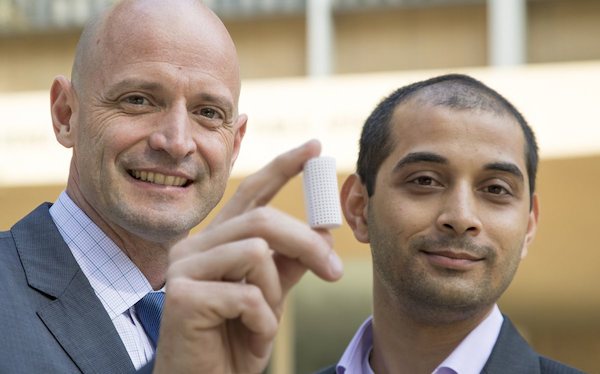
[Image above] J.R. DeShazo, left, director of the UCLA Luskin Center for Innovation, and Gaurav Sant, associate professor in civil and environmental engineering, hold a sample of the new building materials they have created to replace concrete. Credit: Roberto Gudino; UCLA
What if you could convert a detrimental-to-the-earth waste product into a 3-D printed material resource? Sounds like magic, right?
An interdisciplinary team of researchers at the University of California Los Angeles wants to make the magic a reality.
The team has devised a proof-of-concept that shows it’s possible to capture carbon dioxide emissions and convert them into a concrete alternative that can be 3-D printed—a material the researchers are calling CO2NCRETE.
While other researchers have also devised innovative ways to capture carbon emissions, the UCLA team wants to go one step further. The blue-sky idea encompasses an entire process for dealing with carbon emissions—a solution that goes from smokestack to usable alternative building material.
“We hope to not only capture more gas, but we’re going to take that gas and, instead of storing it, which is the current approach, we’re going to try to use it to create a new kind of building material that will replace cement,” professor of public policy J.R. DeShazo says in a UCLA press release.
In addition to the benefit of upcycling carbon dioxide into a new material, the process also could reduce the need for concrete—which in itself is a large contributer to carbon emissions.
The team has developed the idea in the lab, so the next step is perhaps the most challenging one—scale-up towards commercial viability.
“We have proof of concept that we can do this,” DeShazo says in the release. “But we need to begin the process of increasing the volume of material and then think about how to pilot it commercially. It’s one thing to prove these technologies in the laboratory. It’s another to take them out into the field and see how they work under real-world conditions.”
Watch this video to hear more about this blue-sky project from the UCLA researchers themselves.
Credit: UCLA Luskin; Vimeo
Author
April Gocha
CTT Categories
- Cement
- Construction
- Energy
- Environment
- Manufacturing
- Material Innovations


